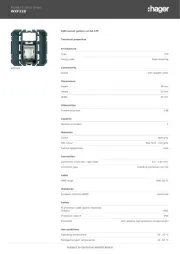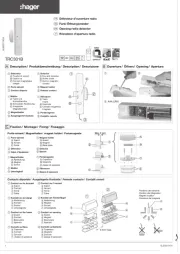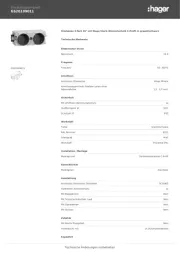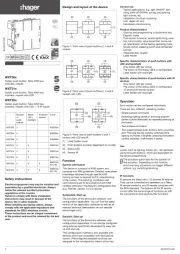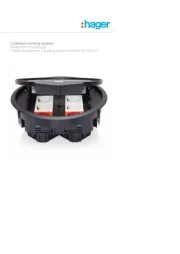KNX radio motion detector comfort
1.1 m quicklink
Order no. 8534 51 ..
KNX radio motion detector comfort
2.2 m quicklink
Order no. 8534 61 ..
Operating and assembly
instructions
Berker GmbH & Co. KG
Zum Gunterstal
66440 Blieskastel, Germany
Tel.: + 49 6842 945 0
Fax: + 49 6842 945 4625
e-mail: info@berker.de
www.berker.com
04/2022
6LE005217D
z
KNX radio motion detector comfort
1.1 m quicklink
KNX radio motion detector comfort
2.2 m quicklink
Safety instructions
Electrical equipment must only be installed
and assembled by a qualied electrician in ac-
cordance with the relevant installation stand-
ards, regulations, directives and safety and ac-
cident prevention directives of the country.
Failure to comply with these instructions may
result in damage to the device, re or other
hazards.
The radio transmission is not suitable for safe-
ty or alarm applications.
Due to its detection behaviour the device is not
suitable for use in burglary detection or alarm
systems.
These instructions are an integral component
of the product and must be retained by the end
user.
Design and layout of the device
(3)
(5)
(6)
(4)
(2) (1)
Fig. 1: Design and layout of the device
(1) Insert
(see "Accessories", not in scope of delivery)
(2) Frame (not included)
(3) Application module
(4) Motion detector design cover
(5) Module retaining screw
(not for Berker R.1/R.3/R.8)
(6) Interface between insert/application module
Function
System information
This device is a product of the quicklink system, in
which installation devices communicate via radio
signals.
quicklink stands for a configuration mode, in which
the function-related connection between trans-
mitters and receivers is set on the device through
buttons and displays without further tools.
All devices configurable by quicklink can be oper-
ated together in one system.
► See configuration instructions.
This device complies with EU Directive 2014/53/EU.
The declaration of conformity and further system
information can be accessed at hager.com.
The device may be operated in all EU and EFTA
states (excluding Switzerland and Liechtenstein).
Correct use
- Automatic switching of lighting depending on
heat motion and ambient brightness
- Application module for switch insert, dimmer
insert or power supply for KNX radio applica-
tion module
- The device has been designed for smaller ap-
plications, in which a maximum of 20 devices
are allocated
- Only suitable for use in indoor areas with no
drip and no spray of water
Product characteristics
- quicklink functions to extend the detection ar-
ea, scenes, control circuits
► See conguration instructions
- Remote control via quicklink transmitter
- Integrated button for selecting operating modes
and special functions
- Lockable integrated button
- The operating modes Automatic, Permanent
ON, Permanent OFF can be selected
- Display operating mode via LED
- Potentiometer for setting the response bright-
ness and detection sensitivity
- Adjustable detection angle for adapting the
detection area
- Additional adjustment of the response bright-
ness via Teach-In function
- Party function
- Presence simulation
- Optional extension unit operation via installa-
tion button
Automatic mode
The motion detector detects heat motion caused
by people, animals, or objects.
On switch insert and dimmer insert with factory
setting:
- The light will be switched on for a xed delay
time of 3 minutes if movements are detected in
the detection area and the set brightness
threshold is undershot. Each additional move-
ment in the detection area restarts the delay
time.
- The light will be switched o after 3 minutes if
no additional movements are detected.
On dimmer insert configured with time function
(see configuration instructions):
- The light will be switched on for the delay time,
if movements are detected in the detection ar-
ea and the set brightness threshold is under-
shot. Each additional movement in the detec-
tion area restarts the delay time.
- After the delay time elapses, the lighting will be
dimmed to 50% of the switch-on brightness
level and will remain at this brightness level for
30 s (switch-o pre-warning). Any motion de-
tected during the switch-o pre-warning re-
starts the delay time and restores the switch-on
brightness level.
- The light will be switched o if no motion is
detected any longer in the detection area and
the set delay time and the switch-o pre-warn-
ing have elapsed.
Performance after mains breakdown/return of
mains supply
- Mains breakdown shorter than 0.2 s:
The function is not impaired.
- Mains breakdown longer than 0.2 s:
There is no function during the mains break-
down. The current conguration is saved in
non-volatile memory.
- Return of mains supply:
The application module executes an initialisa-
tion for approx. 5 s, during which the lighting
will be switched on. Motion detection starts
thereafter. If no motion is detected during the
rst 5 s, the lighting is switched o. The saved
conguration is loaded from memory. During
this period, local operation via the button or
extension unit can be used.
Operation
Operating concept
(8)
(7)
Fig. 2: Display and operating elements
(7) Button
(8) Status LED
Operation is executed by pushing the button (7)
on the motion detector:
- A short press of the button switches the operat-
ing modes. The operating mode is displayed
via the status LED behind the optics cover of
the motion detector.
- Keeping the button pressed activates special
functions. Selection of the special functions is
supported by the LED display (Fig. 3).
Selecting the operating mode
Briefly press the button repeatedly until the
desired operating mode is selected.
The status LED indicates the selected operat-
ing mode (see Table 1).
Switching the operating mode nishes the party
function or presence simulation, if these func-
tions were previously active.
Disabling/enabling operating mode selection
via button
Keep the button pressed for more than 15
seconds, until the status LED is flashing green
(Fig. 3).
Selection of the operating mode via the button
is disabled.
or if the button is locked:
Keep the button pressed for more than 15
seconds, until the status LED is flashing green
(Fig. 3).
The operating mode can be selected via the
button again.
Switching on the lighting via push-button ex-
tension unit or changing the switch-on bright-
ness level
Optionally, the lighting can be switched on via a
mechanical push-button extension unit (Table 2).
For extension unit operation, the lighting is
switched on independently of the set bright-
ness threshold.
When using the dimmer inserts, the last set
brightness level will be saved as the switch-on
brightness level.
Activating/interrupting party function
The party function switches the lighting on for 2
hours. During this time, no extension unit or radio
commands are executed.
Keep the button pressed for more than 5 sec-
onds, until the status LED flashes red (Fig. 3).
The lighting is switched on for 2 hours. During
this time the status LED is flashing red. When
the 2 hours have elapsed, the motion detector
switches to the operating mode.Auto
Briefly press the button.
The party function is interrupted and the motion
detector reverts to the operating mode.Auto
Activating/deactivating the presence simula-
tion
During operation, the motion detector counts the
motion detections in one full hour and saves the
result. With active presence simulation at the
beginning of the hour with the most detections
saved, the light will be switched on for the duration
of the delay time, even no motion is detected.
During the presence simulation, presence de-
tection, extension unit and radio commands will
continue to be executed normally.
Keep the button pressed for more than 20
seconds, until the status LED slowly flashes
red (Figure 3).
The presence simulation is active. During this
time the status LED lights orange. The motion
detector switches the lighting on at the saved
time.
Briefly press the button.
The presence simulation will be deactivated,
the motion detector reverts to the operat-Auto
ing mode.
Settings
Setting response brightness via Teach-In
function
The response brightness is the brightness value
saved in the motion detector; when this value
is undershot the motion detector switches the
connected load if movements are detected. Via
Teach-In function the current ambient bright-
ness is saved as the response brightness.
The load is switched off.
Keep the button pressed for more than 10
seconds, until the status LED flashes orange
(Fig. 3).
The motion detector detects the current
ambient brightness and saves it as response
brightness.
Setting of the response brightness via
Teach-In function and via the brightness po-
tentiometer has the same priority. Teach-In
overwrites the response brightness set on
the brightness potentiometer. If the setting is
made again via the potentiometer , the
Teach-In gure will be overwritten.
Setting the load
If the switching performance is not satisfactory
after commissioning when using the motion de-
tector on universal switch inserts and universal
touch dimmers, a load setting must be carried
out.
